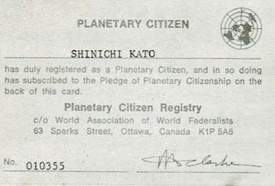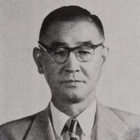From what I have gathered in Japan, the only people who have met Kato, who was born in 1900, are his nephew, Mr. Yoshida, and two others who live near his parents' home, and in the United States there is only one other person, the Hiroshima Prefectural Association in Los Angeles.
While I was wondering if there was anyone who knew Kato among those involved in the peace movement in which he was actively involved in his later years, I happened to find a clue at Hiroshima City Hall. When I visited the Relief Section of the Atomic Bomb Victims Countermeasures Department of the Hiroshima City Health and Welfare Bureau to find out about Kato's younger sister and brother who died in the atomic bombing, I obtained a copy of the "Outline of the Atomic Bomb Victims Response Project" (2019 edition).
At the end of the publication, which summarized the damage caused by the atomic bomb and measures for victims, there was a seven-page list of names, addresses, and contact information for various organizations titled "List of Peace-Related Organizations." Among them, I found the "World Federalist Movement Association Hiroshima Branch." It was an organization that Kato had been deeply involved with during his lifetime.
The detailed address was listed as "Morishita Mineko's House." I immediately called the contact number and was able to speak to Ms. Morishita after a few tries. When I explained that I was researching Kato Shinichi, Ms. Morishita not only knew of Kato, but said that she had met him about 50 years ago.
A kind and passionate man
I asked Mr. Morishita to arrange a meeting in Hiroshima and tell me his story. Born in 1948, Mr. Morishita has been involved in the World Federation movement since he was young, and served as an officer in the "Second World Federation Peace Promotion Religious Conference" in August 1970, where Kato served as Secretary General.
Morishita, who has had several interactions with his energetic senior Kato, describes his impression of him at the time as follows:
"Kato-san reminds me of a bear, a character that appears in literature with a strong regional flavor set in the American South. He was a large, well-built man with a relaxed and warm demeanor. He was a kind, passionate man."
Morishita said he had the same impression of Kato as the few other people who knew him. He also said he was enthusiastic about spreading the concept of "global citizenship" under the ideal of a world federation, a single government across national borders.
Morishita-san pointed me to "The 25-Year History of the World Federalist Movement in Hiroshima" (published in June 1972), and from the "Afterword" written by Kato and key points of the movement around 1972, I could understand Kato's thoughts about global citizens.
Become one of the first to register as a global citizen

The concept of "global citizen" was originally proposed by U Thant, who was Secretary-General of the United Nations. In the afterword, Kato writes, "The 'Global Citizen Campaign' was proposed by then Secretary-General U Thant, who, after ten years of hard work in running the UN, believed that the weakness of the UN was due to each country's tendency to cling to national sovereignty, and that the first priority was to cultivate a sense of community of shared future among the people, who are the sovereigns of the world. The WAWF (World Association of World Federalists, the predecessor of the World Federalist Movement) took up this idea, declared U Thant the 'first global citizen,' and launched the campaign..."
The first manifesto was made by Norman Cousins, president of the World Federalist World Association, who expanded the movement worldwide and called for the registration of global citizens.
A movement responding to this was also taking place in Japan. Kato, who had created the "Association of Friends of Earthlings" in Hiroshima, immediately registered as a global citizen with WAWF, setting the pace for the movement in Japan. Following Kato, Hiroshima Mayor Yamada Setsuo and others also registered one after another. This again shows Kato's ability to take action.
In August 1972, the Japanese side prepared a draft of the "Declaration of the Inter-Existence of the Earth's Peoples" to be presented in Hiroshima as a campaign policy for the 15th World Congress of the World Federalist World Association to be held in Brussels. Kato is thought to have been the central figure in this.
Instead of "coexistence," they deliberately used the coined word "competition." This seems to mean coexistence while acknowledging competition.
We share a common destiny
Kato explains this mutual survival of humans on Earth in his "25-Year History" as follows:
"We, the human race, are 'Earthlings', a community of one common destiny living on one planet Earth under the great laws of the universal life force, and we deeply respect the dignity of all human beings, and the mutual love based on freedom, equality and brotherhood.
We, as fellow human beings on Earth, recognize that differences in race, skin color, sex, age, religion and political beliefs are natural, and that differences in collective systems and ideals are stimulating factors for the creative development and happiness of humanity.
It is the immediate responsibility of all of us, men and women, young and old, to create a law of living that will last forever and universally exist in harmony with the diversity of our differences, and it is our purpose in life to work toward the realization of lasting peace (World Federation)."
Furthermore, at the end of the afterword, he expresses his hope for the role that Japanese people can play as world federalists, and concludes with the following old-fashioned but determined statement:
"Can Japanese Federalists become the vanguard of a glorious Japan in the restoration of the world in this global era? Only future generations will be able to judge that."
Kato's words may seem lofty but also unrealistically idealistic, and ironically, they seem like something the world should ponder right now as it faces global challenges such as the coronavirus pandemic and climate change.
(Titles omitted)
© 2021 Ryusuke Kawai






